Rob Fergus
Language Agents Mirror Human Causal Reasoning Biases. How Can We Help Them Think Like Scientists?
May 14, 2025Abstract:Language model (LM) agents are increasingly used as autonomous decision-makers who need to actively gather information to guide their decisions. A crucial cognitive skill for such agents is the efficient exploration and understanding of the causal structure of the world -- key to robust, scientifically grounded reasoning. Yet, it remains unclear whether LMs possess this capability or exhibit systematic biases leading to erroneous conclusions. In this work, we examine LMs' ability to explore and infer causal relationships, using the well-established "Blicket Test" paradigm from developmental psychology. We find that LMs reliably infer the common, intuitive disjunctive causal relationships but systematically struggle with the unusual, yet equally (or sometimes even more) evidenced conjunctive ones. This "disjunctive bias" persists across model families, sizes, and prompting strategies, and performance further declines as task complexity increases. Interestingly, an analogous bias appears in human adults, suggesting that LMs may have inherited deep-seated reasoning heuristics from their training data. To this end, we quantify similarities between LMs and humans, finding that LMs exhibit adult-like inference profiles (but not children-like). Finally, we propose a test-time sampling method which explicitly samples and eliminates hypotheses about causal relationships from the LM. This scalable approach significantly reduces the disjunctive bias and moves LMs closer to the goal of scientific, causally rigorous reasoning.
BALROG: Benchmarking Agentic LLM and VLM Reasoning On Games
Nov 20, 2024



Abstract:Large Language Models (LLMs) and Vision Language Models (VLMs) possess extensive knowledge and exhibit promising reasoning abilities; however, they still struggle to perform well in complex, dynamic environments. Real-world tasks require handling intricate interactions, advanced spatial reasoning, long-term planning, and continuous exploration of new strategies-areas in which we lack effective methodologies for comprehensively evaluating these capabilities. To address this gap, we introduce BALROG, a novel benchmark designed to assess the agentic capabilities of LLMs and VLMs through a diverse set of challenging games. Our benchmark incorporates a range of existing reinforcement learning environments with varying levels of difficulty, including tasks that are solvable by non-expert humans in seconds to extremely challenging ones that may take years to master (e.g., the NetHack Learning Environment). We devise fine-grained metrics to measure performance and conduct an extensive evaluation of several popular open-source and closed-source LLMs and VLMs. Our findings indicate that while current models achieve partial success in the easier games, they struggle significantly with more challenging tasks. Notably, we observe severe deficiencies in vision-based decision-making, as models perform worse when visual representations of the environments are provided. We release BALROG as an open and user-friendly benchmark to facilitate future research and development in the agentic community.
Training Language Models on Synthetic Edit Sequences Improves Code Synthesis
Oct 03, 2024

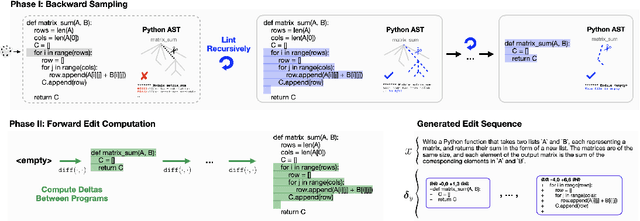
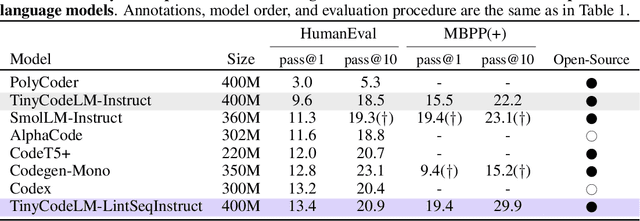
Abstract:Software engineers mainly write code by editing existing programs. In contrast, large language models (LLMs) autoregressively synthesize programs in a single pass. One explanation for this is the scarcity of open-sourced edit data. While high-quality instruction data for code synthesis is already scarce, high-quality edit data is even scarcer. To fill this gap, we develop a synthetic data generation algorithm called LintSeq. This algorithm refactors existing code into a sequence of code edits by using a linter to procedurally sample across the error-free insertions that can be used to sequentially write programs. It outputs edit sequences as text strings consisting of consecutive program diffs. To test LintSeq, we use it to refactor a dataset of instruction + program pairs into instruction + program-diff-sequence tuples. Then, we instruction finetune a series of smaller LLMs ranging from 2.6B to 14B parameters on both the re-factored and original versions of this dataset, comparing zero-shot performance on code synthesis benchmarks. We show that during repeated sampling, edit sequence finetuned models produce more diverse programs than baselines. This results in better inference-time scaling for benchmark coverage as a function of samples, i.e. the fraction of problems "pass@k" solved by any attempt given "k" tries. For example, on HumanEval pass@50, small LLMs finetuned on synthetic edit sequences are competitive with GPT-4 and outperform models finetuned on the baseline dataset by +20% (+/-3%) in absolute score. Finally, we also pretrain our own tiny LMs for code understanding. We show that finetuning tiny models on synthetic code edits results in state-of-the-art code synthesis for the on-device model class. Our 150M parameter edit sequence LM matches or outperforms code models with twice as many parameters, both with and without repeated sampling, including Codex and AlphaCode.
A Fresh Take on Stale Embeddings: Improving Dense Retriever Training with Corrector Networks
Sep 03, 2024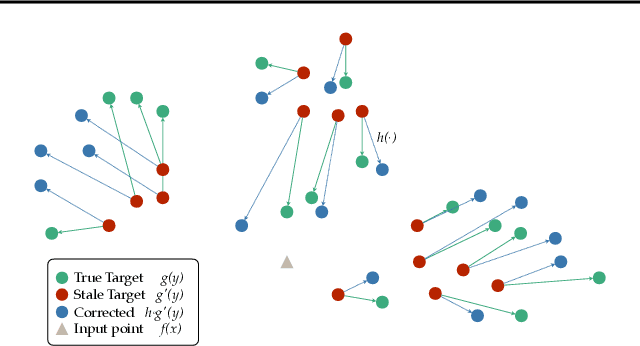
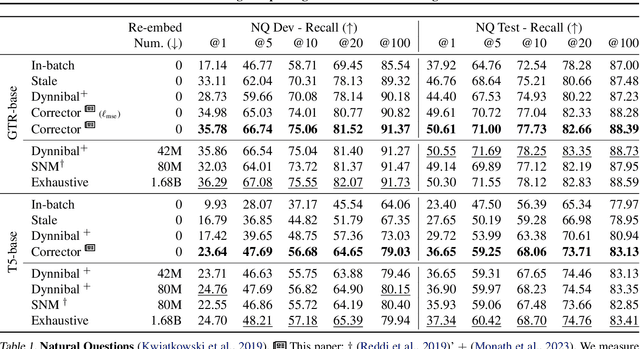
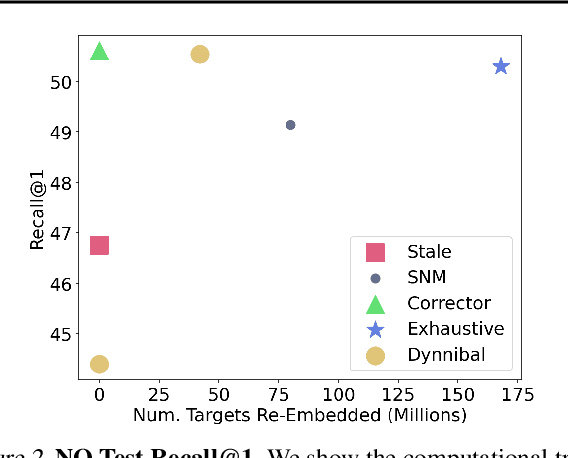
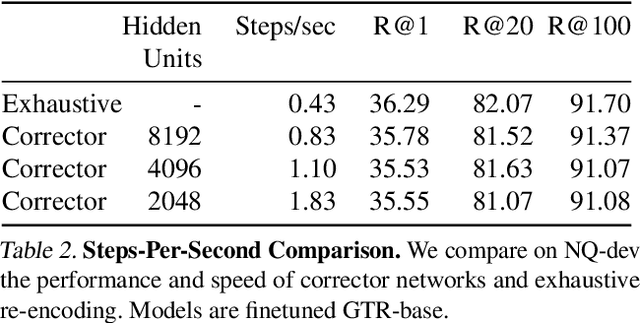
Abstract:In dense retrieval, deep encoders provide embeddings for both inputs and targets, and the softmax function is used to parameterize a distribution over a large number of candidate targets (e.g., textual passages for information retrieval). Significant challenges arise in training such encoders in the increasingly prevalent scenario of (1) a large number of targets, (2) a computationally expensive target encoder model, (3) cached target embeddings that are out-of-date due to ongoing training of target encoder parameters. This paper presents a simple and highly scalable response to these challenges by training a small parametric corrector network that adjusts stale cached target embeddings, enabling an accurate softmax approximation and thereby sampling of up-to-date high scoring "hard negatives." We theoretically investigate the generalization properties of our proposed target corrector, relating the complexity of the network, staleness of cached representations, and the amount of training data. We present experimental results on large benchmark dense retrieval datasets as well as on QA with retrieval augmented language models. Our approach matches state-of-the-art results even when no target embedding updates are made during training beyond an initial cache from the unsupervised pre-trained model, providing a 4-80x reduction in re-embedding computational cost.
Efficient Exploration and Discriminative World Model Learning with an Object-Centric Abstraction
Aug 21, 2024Abstract:In the face of difficult exploration problems in reinforcement learning, we study whether giving an agent an object-centric mapping (describing a set of items and their attributes) allow for more efficient learning. We found this problem is best solved hierarchically by modelling items at a higher level of state abstraction to pixels, and attribute change at a higher level of temporal abstraction to primitive actions. This abstraction simplifies the transition dynamic by making specific future states easier to predict. We make use of this to propose a fully model-based algorithm that learns a discriminative world model, plans to explore efficiently with only a count-based intrinsic reward, and can subsequently plan to reach any discovered (abstract) states. We demonstrate the model's ability to (i) efficiently solve single tasks, (ii) transfer zero-shot and few-shot across item types and environments, and (iii) plan across long horizons. Across a suite of 2D crafting and MiniHack environments, we empirically show our model significantly out-performs state-of-the-art low-level methods (without abstraction), as well as performant model-free and model-based methods using the same abstraction. Finally, we show how to reinforce learn low level object-perturbing policies, as well as supervise learn the object mapping itself.
Cambrian-1: A Fully Open, Vision-Centric Exploration of Multimodal LLMs
Jun 24, 2024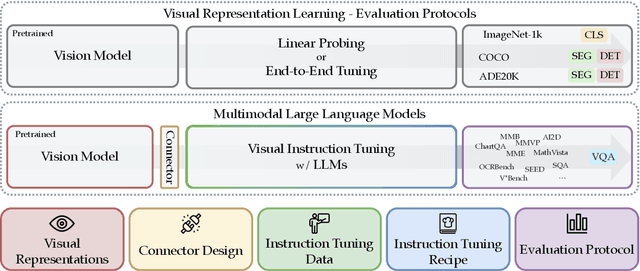



Abstract:We introduce Cambrian-1, a family of multimodal LLMs (MLLMs) designed with a vision-centric approach. While stronger language models can enhance multimodal capabilities, the design choices for vision components are often insufficiently explored and disconnected from visual representation learning research. This gap hinders accurate sensory grounding in real-world scenarios. Our study uses LLMs and visual instruction tuning as an interface to evaluate various visual representations, offering new insights into different models and architectures -- self-supervised, strongly supervised, or combinations thereof -- based on experiments with over 20 vision encoders. We critically examine existing MLLM benchmarks, addressing the difficulties involved in consolidating and interpreting results from various tasks, and introduce a new vision-centric benchmark, CV-Bench. To further improve visual grounding, we propose the Spatial Vision Aggregator (SVA), a dynamic and spatially-aware connector that integrates high-resolution vision features with LLMs while reducing the number of tokens. Additionally, we discuss the curation of high-quality visual instruction-tuning data from publicly available sources, emphasizing the importance of data source balancing and distribution ratio. Collectively, Cambrian-1 not only achieves state-of-the-art performance but also serves as a comprehensive, open cookbook for instruction-tuned MLLMs. We provide model weights, code, supporting tools, datasets, and detailed instruction-tuning and evaluation recipes. We hope our release will inspire and accelerate advancements in multimodal systems and visual representation learning.
Adaptive Retrieval and Scalable Indexing for k-NN Search with Cross-Encoders
May 06, 2024Abstract:Cross-encoder (CE) models which compute similarity by jointly encoding a query-item pair perform better than embedding-based models (dual-encoders) at estimating query-item relevance. Existing approaches perform k-NN search with CE by approximating the CE similarity with a vector embedding space fit either with dual-encoders (DE) or CUR matrix factorization. DE-based retrieve-and-rerank approaches suffer from poor recall on new domains and the retrieval with DE is decoupled from the CE. While CUR-based approaches can be more accurate than the DE-based approach, they require a prohibitively large number of CE calls to compute item embeddings, thus making it impractical for deployment at scale. In this paper, we address these shortcomings with our proposed sparse-matrix factorization based method that efficiently computes latent query and item embeddings to approximate CE scores and performs k-NN search with the approximate CE similarity. We compute item embeddings offline by factorizing a sparse matrix containing query-item CE scores for a set of train queries. Our method produces a high-quality approximation while requiring only a fraction of CE calls as compared to CUR-based methods, and allows for leveraging DE to initialize the embedding space while avoiding compute- and resource-intensive finetuning of DE via distillation. At test time, the item embeddings remain fixed and retrieval occurs over rounds, alternating between a) estimating the test query embedding by minimizing error in approximating CE scores of items retrieved thus far, and b) using the updated test query embedding for retrieving more items. Our k-NN search method improves recall by up to 5% (k=1) and 54% (k=100) over DE-based approaches. Additionally, our indexing approach achieves a speedup of up to 100x over CUR-based and 5x over DE distillation methods, while matching or improving k-NN search recall over baselines.
diff History for Long-Context Language Agents
Dec 12, 2023
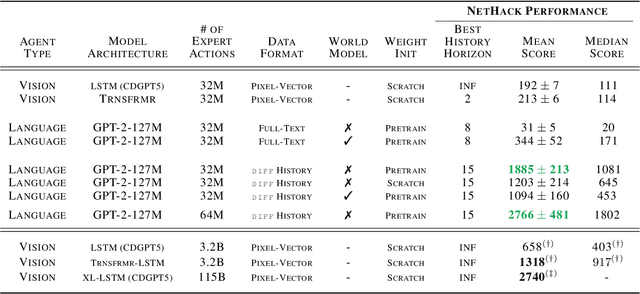
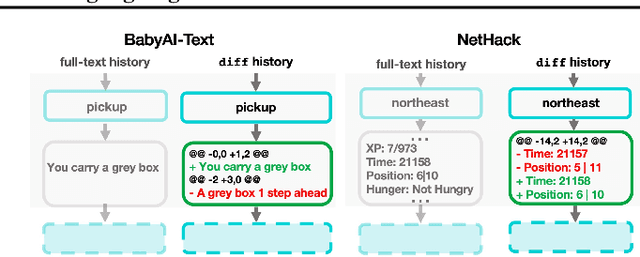
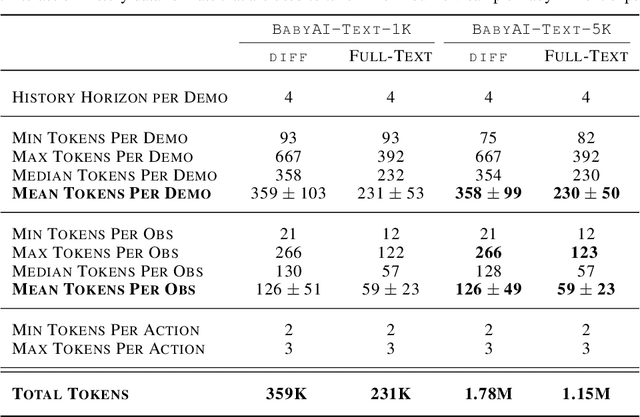
Abstract:Language Models (LMs) offer an exciting solution for general-purpose embodied control. However, a key technical issue arises when using an LM-based controller: environment observations must be converted to text, which coupled with history, leads to prohibitively large textual prompts. As a result, prior work in LM agents is limited to restricted domains with either small observation size or minimal needs for interaction history. In this paper, we introduce a simple and highly effective solution to these issues. We exploit the fact that consecutive text observations have high similarity and propose to compress them via the Unix diff command. We demonstrate our approach in NetHack, a complex rogue-like video game, that requires long-horizon reasoning for decision-making and is far from solved, particularly for neural agents. Diff history offers an average of 4x increase in the length of the text-based interaction history available to the LM. This observational compression along with the benefits of abstraction yields a 7x improvement in game score on held-out environment instances over state-of-the-art baselines. It also outperforms prior agents that use visual observations by over 40%.
Hierarchical reinforcement learning with natural language subgoals
Sep 20, 2023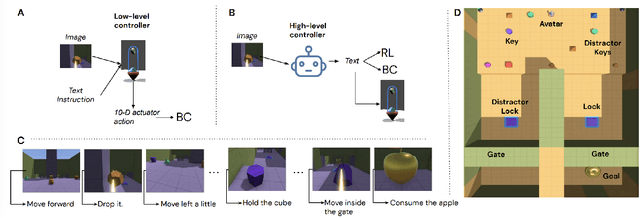
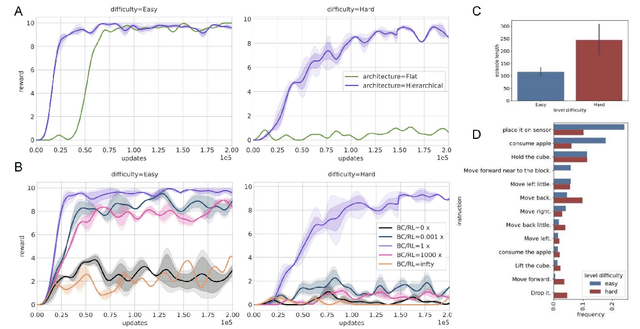
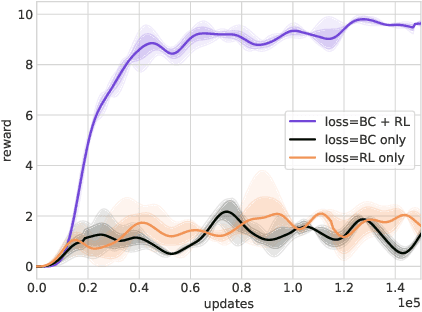
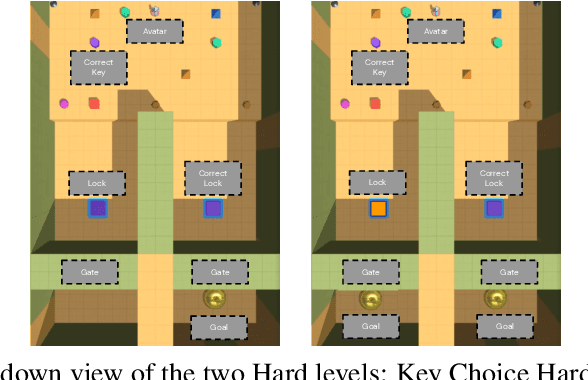
Abstract:Hierarchical reinforcement learning has been a compelling approach for achieving goal directed behavior over long sequences of actions. However, it has been challenging to implement in realistic or open-ended environments. A main challenge has been to find the right space of sub-goals over which to instantiate a hierarchy. We present a novel approach where we use data from humans solving these tasks to softly supervise the goal space for a set of long range tasks in a 3D embodied environment. In particular, we use unconstrained natural language to parameterize this space. This has two advantages: first, it is easy to generate this data from naive human participants; second, it is flexible enough to represent a vast range of sub-goals in human-relevant tasks. Our approach outperforms agents that clone expert behavior on these tasks, as well as HRL from scratch without this supervised sub-goal space. Our work presents a novel approach to combining human expert supervision with the benefits and flexibility of reinforcement learning.
NetHack is Hard to Hack
May 30, 2023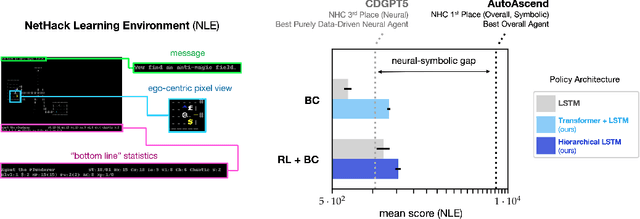
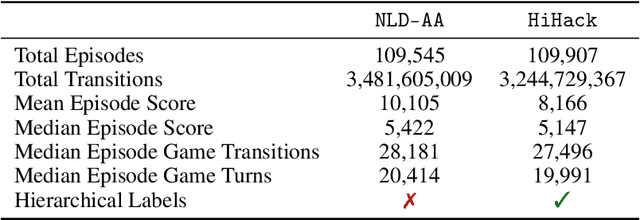

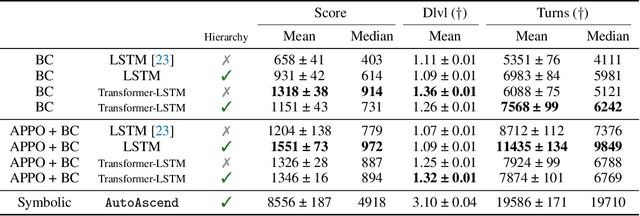
Abstract:Neural policy learning methods have achieved remarkable results in various control problems, ranging from Atari games to simulated locomotion. However, these methods struggle in long-horizon tasks, especially in open-ended environments with multi-modal observations, such as the popular dungeon-crawler game, NetHack. Intriguingly, the NeurIPS 2021 NetHack Challenge revealed that symbolic agents outperformed neural approaches by over four times in median game score. In this paper, we delve into the reasons behind this performance gap and present an extensive study on neural policy learning for NetHack. To conduct this study, we analyze the winning symbolic agent, extending its codebase to track internal strategy selection in order to generate one of the largest available demonstration datasets. Utilizing this dataset, we examine (i) the advantages of an action hierarchy; (ii) enhancements in neural architecture; and (iii) the integration of reinforcement learning with imitation learning. Our investigations produce a state-of-the-art neural agent that surpasses previous fully neural policies by 127% in offline settings and 25% in online settings on median game score. However, we also demonstrate that mere scaling is insufficient to bridge the performance gap with the best symbolic models or even the top human players.
 Add to Chrome
Add to Chrome Add to Firefox
Add to Firefox Add to Edge
Add to Edge